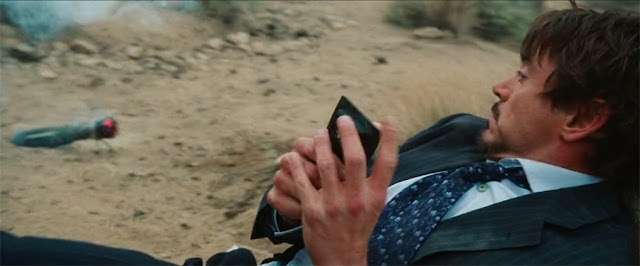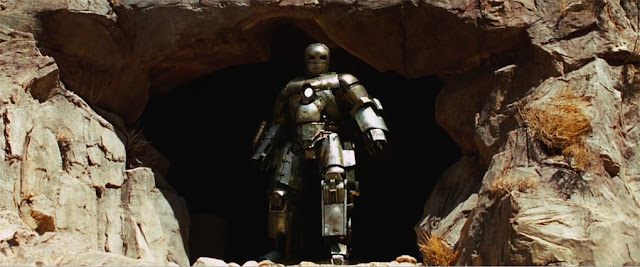Tony Chastising his robot arm
Check the hilighted text
AI with Personality
At the casino where Obie accepts Tony's award while Tony is gambling, there's a brief video presentation about Tony's life. I freeze-framed on the newspaper and magazine articles and found something really interesting. When he was an MIT junior at 16, Tony developed a thesis that artificial intelligence could be imbued with personality through some kind of simple but radical algorithm. This idea of AI with personality echoes through the entire film, starting with the robot arm in the workshop. Whether it's aiming a fire extinguisher at him or saving his life by handing him his original tech-heart after Obie stole the new one, it always has an eager-to-please puppy dog personality, as if it contains a chunk of Tony's youthful exuberance, an imprint from the time he created it.
This sets viewers up to accept the MK II armor later, imbued with Jarvis' intelligence and personality. Unlike any of today's computer 'personalities' though—like Siri—Jarvis seems to get humor and sarcasm unerringly, and uses it himself. It allows Tony's technology to interact with him like a human being, friendly and personable, rather than clinical like all other tech, though Jarvis does have a very dry English-style sense of humor.
It's as if Tony has so much personality that it oozes from him into everything he designs or builds.
Hi-Tech Security
The armor itself is made in many layers, including pieces of mesh just like the athletic gear that was so popular at the time. In addition to that, Tony is cocooned in a nested series of holographic interfaces that seem to extend outside of the helmet into the air around him. Taken together this gives a strong feeling of being wrapped up and protected, almost like a baby in swaddling clothes. In fact it reminds me of how I used to feel as a kid when I'd snuggle into a sleeping bag out in the back yard or later in a tent in the woods. Or getting in a sweet sports car on a hot day and cranking up the AC and the tunes, and when you hit the highway it's got super-smooth suspension and accelerates like a dream. It's like he's got security blankets made of high-tech metals and AI interfaces. This all relates to his emotionally and physically absent father, which figures into the story in several other forms as well. I'll cover that in its own section.
Over and above the extreme physical security provided by the armor and weaponry, this provides him with emotional security. This is an important element, since Tony is driven by fear that blooms into paranoia in the second movie and anxiety attacks in the third. Remember the reason he made armor in the first place was to protect himself, not only against the Stark weapons wielded by the terrorists in their cave hideout, but originally against his own missile that his body armor was unable to protect him against. And that was psychologically a symbol of his own nature at the time, as a heartless warmonger creating the best weapons the world had ever seen and allowing them to fall into the hands of terrorists. So ultimately the reason he needs all the layers of physical and emotional protection is against his own inner nature, his dark self-image or his ghost-self. It's essentially himself he's fighting. This is why it's perfect that the weaponry the terrorists use has his name stamped on each piece. Plus he feels abandoned and unprotected by his father. This probably contributed to his rebellious smart-ass nature.
Constant Upgrades
I believe the growing terror is also what's behind his constant upgrading of the armor, that plus it links in with the arms race, where constant advances make last year's technology obsolete so that the superpowers keep winning against 3rd world countries using their own weapons from 10 years ago.
But another thing it does is remind people of the tech they use every day. His interfaces are like advanced versions of video games or computer browsers, only in his case they have physical reality and allow him to fly around and kick some ass. We're all familiar with the need to upgrade our computer's operating system frequently, often for security reasons. Hence the endless parade of new armor versions. It seems to be a compulsion designed to keep him busy, to continually perfectify his security measures, in the way some people can never be clean enough or keep organizing and cleaning the house even when it's spotless.
I know on the surface he seems cool and charismatic, but that's the last remnant of his former emotional armoring—it's the calm face he shows the world to hide the nervousness and inner terror that came welling out when he was cracked open like a walnut by Christine Everhart's revelation of his true inner nature. Is it just a weird coincidence that stark means naked? Yeah, probably. But hey, symbolism doesn't need to be consciously inserted by the author or artist, often it happens completely unconsciously. Ok, yeah, it's a weird coincidence.
Terrorism
Terrorists and terrorism make perfect externalized symbols for Tony's inner terror—the real driver of his technological developments, his heroism, and the movie itself. It's the opposite of the Black Sabbath line "Kills the people he once saved". In order to redeem himself Tony must now save the people he once callously allowed to be killed—soldiers and innocents. In a sense he represents America—the American people—realizing it was the policy of their government or some faction of it that created the terrorists and caused all the killing and endless war in the Middle East, and now he's armoring up like a high-tech Charles Bronson to work some vigilante justice and set things right, after doing his part toward disarming by halting the manufacture of Stark weapons.
Over and above the extreme physical security provided by the armor and weaponry, this provides him with emotional security. This is an important element, since Tony is driven by fear that blooms into paranoia in the second movie and anxiety attacks in the third. Remember the reason he made armor in the first place was to protect himself, not only against the Stark weapons wielded by the terrorists in their cave hideout, but originally against his own missile that his body armor was unable to protect him against. And that was psychologically a symbol of his own nature at the time, as a heartless warmonger creating the best weapons the world had ever seen and allowing them to fall into the hands of terrorists. So ultimately the reason he needs all the layers of physical and emotional protection is against his own inner nature, his dark self-image or his ghost-self. It's essentially himself he's fighting. This is why it's perfect that the weaponry the terrorists use has his name stamped on each piece. Plus he feels abandoned and unprotected by his father. This probably contributed to his rebellious smart-ass nature.
Constant Upgrades
I believe the growing terror is also what's behind his constant upgrading of the armor, that plus it links in with the arms race, where constant advances make last year's technology obsolete so that the superpowers keep winning against 3rd world countries using their own weapons from 10 years ago.
But another thing it does is remind people of the tech they use every day. His interfaces are like advanced versions of video games or computer browsers, only in his case they have physical reality and allow him to fly around and kick some ass. We're all familiar with the need to upgrade our computer's operating system frequently, often for security reasons. Hence the endless parade of new armor versions. It seems to be a compulsion designed to keep him busy, to continually perfectify his security measures, in the way some people can never be clean enough or keep organizing and cleaning the house even when it's spotless.
I know on the surface he seems cool and charismatic, but that's the last remnant of his former emotional armoring—it's the calm face he shows the world to hide the nervousness and inner terror that came welling out when he was cracked open like a walnut by Christine Everhart's revelation of his true inner nature. Is it just a weird coincidence that stark means naked? Yeah, probably. But hey, symbolism doesn't need to be consciously inserted by the author or artist, often it happens completely unconsciously. Ok, yeah, it's a weird coincidence.
Terrorism
Terrorists and terrorism make perfect externalized symbols for Tony's inner terror—the real driver of his technological developments, his heroism, and the movie itself. It's the opposite of the Black Sabbath line "Kills the people he once saved". In order to redeem himself Tony must now save the people he once callously allowed to be killed—soldiers and innocents. In a sense he represents America—the American people—realizing it was the policy of their government or some faction of it that created the terrorists and caused all the killing and endless war in the Middle East, and now he's armoring up like a high-tech Charles Bronson to work some vigilante justice and set things right, after doing his part toward disarming by halting the manufacture of Stark weapons.



































